Sept 13
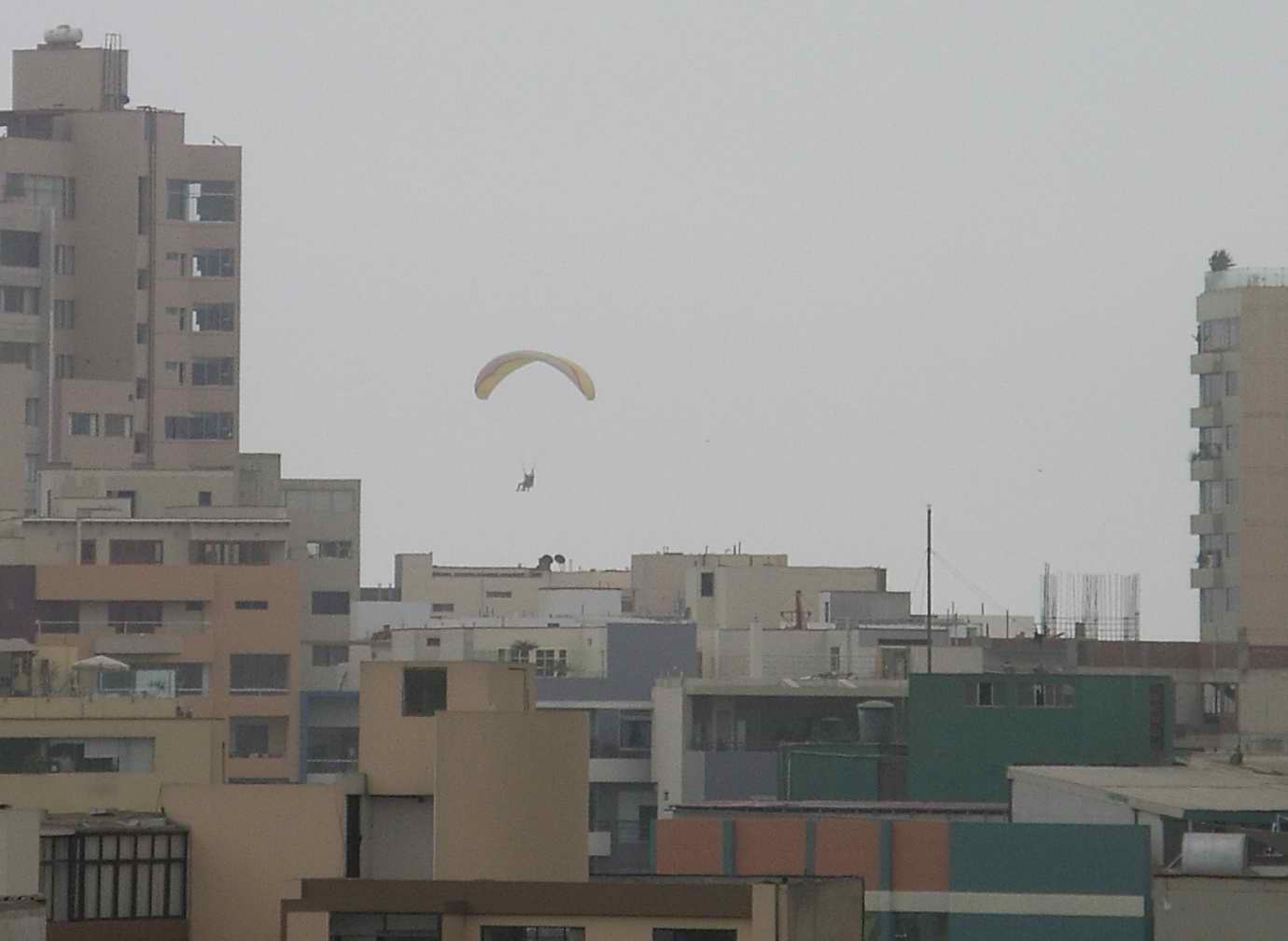
What an exciting day!
1. Pack
2. Go out for coffee & check briefing for group
3. Check-out & walk to other hotel
4. Check in to other hotel ..OK, that's enough!
.......I did go for a run along the cliff at Miraflores, with great views down on to the surfers and up at the paragliders. Then I climbed up the loose pebbly cliffs on the path labelled 'Danger, Closed' - well, it was the quickest way....
15. Get on coach to airport (including getting a very useful briefing from the outgoing leader, Verena).
16. Find flight delayed
17. Meet group
18. Coach to hotel
19. Dinner with 80% of group, looking distinctly travel worn.
20. Bed
Paraglider
over Miraflores
Sept 14
Off to the airport again! I was overjoyed at getting away from Lima at last....however the airline had other ideas - first it tried to stop me joining the rest of the group on the flight by finding some fundamental problems with my ticket, then, having cunningly paid $148 for another ticket, that the flight was full & I would have to follow 4 hours later. Finding that I could talk my way onto the 'proper' flight, provided someone else didn't turn up, they delayed the 'proper' flight by almost 3 hours. I successfully got on the 'proper' flight, but of course my luggage didn't.....
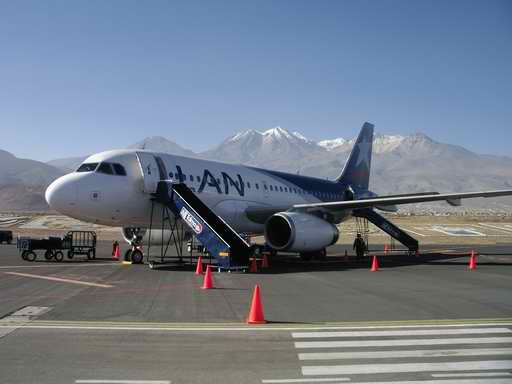 But once up
in the air, wow! The views down onto desert between the coast and the
Andes was awe inspiring - dry, dry,dry. Great valleys with meandering
dry stream beds. Occasionally there were the traces of a trail winding
along the ridge tops. Nearer Arequipa the rounded peaks of Coropuna
appeared & I thought of the account I had recently read of the
struggle that Hireham Bingham had to reach the peak, and then climb it
in 1915 - and here we were whizzing over it in minutes! The ends of
several canyons could be seen meeting below, with some green in the
valley bottoms. We landed in Arequipa, coming down over mud coloured
shanty dwellings of Cono Norte below the snow covered peak of
Chachani. The overcast misty conditions of Lima swapped for the
semi-desert sun of Arequipa...
But once up
in the air, wow! The views down onto desert between the coast and the
Andes was awe inspiring - dry, dry,dry. Great valleys with meandering
dry stream beds. Occasionally there were the traces of a trail winding
along the ridge tops. Nearer Arequipa the rounded peaks of Coropuna
appeared & I thought of the account I had recently read of the
struggle that Hireham Bingham had to reach the peak, and then climb it
in 1915 - and here we were whizzing over it in minutes! The ends of
several canyons could be seen meeting below, with some green in the
valley bottoms. We landed in Arequipa, coming down over mud coloured
shanty dwellings of Cono Norte below the snow covered peak of
Chachani. The overcast misty conditions of Lima swapped for the
semi-desert sun of Arequipa...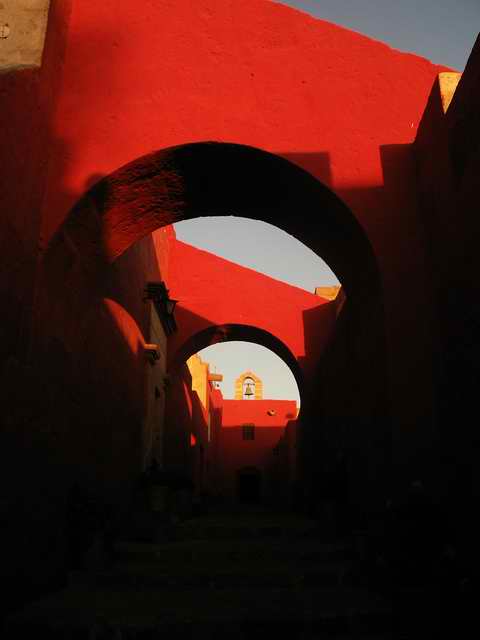
Arrival at Arequipa with Chachani in background
By the time I had finished reporting my last luggage and we had reached the hotel the best part of the afternoon had gone - but the Monasterio de Santa Catalina was still open, so we had a tour as the sun gradually sank and the sky became pinker. This made the red painted stone walls in the maze of narrow streets separating the nuns quarters go blood red - suggesting life rather than death! By the time we had threaded through the stone remains of what must have been a class ridden comfortable cloistered existence it was dark. Our enthusiastic guide, Francisco, led us off to the main square, where the lights glowed against the white volcanic rock of the cathedral, contrasting with the blackness all around. Inside the cathedral mass was being celebrated - it could have been anywhere in Catholic Europe from the decor, not a hint of Peru. It was time to go back - but no, Francisco herded us off to the Iglesia de la Compania - with a highly ornate facade with various native elements ( a puma for example) incorporated into the design. But we got back, in the end for food. It was during dinner that my bag arrived............
Alley
in Monasterio de Santa Catalina
Sept 15 Arequipa from Yanahuara
Arequipa from Yanahuara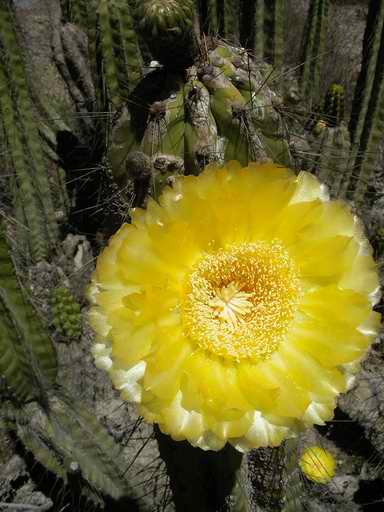
The day started with a rapid trip to viewpoints over Arequipa & the surrounding volcanoes, before setting off to go round the back of the volcanoes and up to the highest point of the trip at 4,750m en route to Colca Canyon. Stunning views of semi-desert scenery & distant snow-capped volcanoes. The first part of the journey was on mettalled road with frequent heavy lorries (with large signs saying 'combustible liquids') hurtling towards us. My brain definitely felt as though it was shrinking as we got higher, but the headache never really developed - unlike for a few of the others - 2 were rather ill.
After some difficult finding lunch in Chivay we headed off to Yanque, with its beautiful stocky white Spanish colonial church, and then down a very rough dirt road into the valley & over the river Colca to reach Colca Lodge - an African style set of individual or terraced lodges down by the river. The main attraction (apart from a bed, and the excellent local food) was the set of hot springs, where most of us spent a happy half hour stewing at 37 degrees. Out of the water it was cool - full moon on its way & a cold wind blowing up the valley. Next morning there was ice in the irrigation ditches....
Cactus
flower
Sept 16
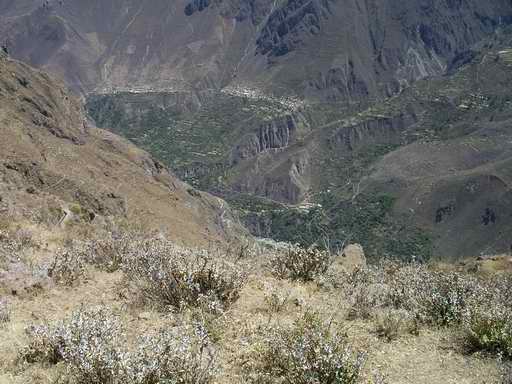
Up horribly early in order to drive to the Colca Canyon lookout point at Cruz de Condor, above the cliffs housing the condor nests. Arriving at the point was a convoy of coaches, all throwing up clouds of dust. The rocks were covered in people, if the condors had any sense they would go elsewhere! Our first sighting was of a small black dot moving over a kilometer below us - it was about an hour later when all of a sudden 4 condors took it into their heads to do a fly-past on the warming air currents. What a privilege to be able to look down on a gliding condor relatively close by - beautiful white wings outlined in black (apart from the juveniles that were dirty brown). Although Colca Canyon is deeper than the Grand Canyon it has no distinct rim, and therefore lacks the same drama. But the Grand Canyon lacks the impossibly located villages and terraced mountain sides. We had a great view of some of these, and the dramatic trails giving access to the villages, as we did a 2 hour walk down to the village of Cabanaconde.
Villages
in Colca Canyon
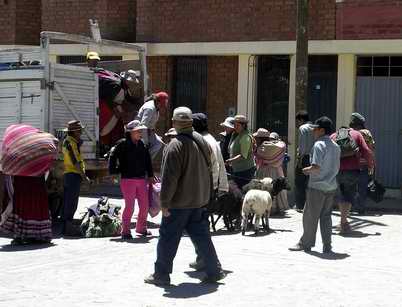
We arrived about the same time as a lorry packed with people. It was only when this stopped to unload that we realised that many of the passengers were accompanied by sheep! Around this village the wall enclosed fields were all ploughed ready to plant corn. In some places broad beans were already on the way up, and between the fields you could see ribbons of irrigating water.
Needless to say, every viewpoint had a gathering of locals in their gaily coloured clothes selling various things. On our way back we stopped at one point and had fresh prickly pears - very juicy, a bit pippy, and a bit like melon inflavour - all for one sol (20p) each.
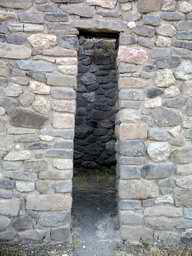 Before relaxing (back
in the hot pool!) I walked up to the 'Conjunto Arqueologico Uyo-Uyo',
which was a deserted pre-Columbian village, apparently cleared out by
the Spanish who settled the inhabitants (those left alive) in a new
village - now known as Yanque - on the other side of the Colca river .
Many of the walls remained up to roof level, and although they were
mainly made of river pebbles and odd stones they were remarkably
well finished. A lined water channel ran the length of the sloping main
street, fed by a waterfall high up above the village.
Before relaxing (back
in the hot pool!) I walked up to the 'Conjunto Arqueologico Uyo-Uyo',
which was a deserted pre-Columbian village, apparently cleared out by
the Spanish who settled the inhabitants (those left alive) in a new
village - now known as Yanque - on the other side of the Colca river .
Many of the walls remained up to roof level, and although they were
mainly made of river pebbles and odd stones they were remarkably
well finished. A lined water channel ran the length of the sloping main
street, fed by a waterfall high up above the village.People and sheep disembarking in Cabanaconde
Doorway
in Uyo-Uyo
Sept 17
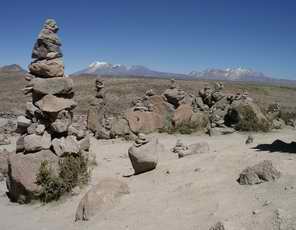 We had to
tear ourselves away from the good food & hot pools of Colca Lodge -
but with Lake Titicaca as our destination that was OK. OK was not how
several peoples' stomachs were, unfortunately, - either from the food
or the altitude. So it was a slightly subdued party heading back up to
the highest point of the holiday again on the pass back to the main
Arequipa - Puno road. We stopped at the top this time to view the bare
landscape, littered with stone piles of all sizes, and with clear views
of distant snow capped (extinct) volcanoes & one smoking volcano.
We spent most of the day over 4,000m driving through semi-desert
landscape with occasional flocks of alpaca or llamas or sheep grazing
on the distinctly dry looking coarse fescue grass. We saw several large
birds of prey - the mountain caracara and black-chested buzzard eagle
to name but two - and Peruvian geese in some of the many boggy spots.
En route, in a small lake, we saw plenty of flamingos.
We had to
tear ourselves away from the good food & hot pools of Colca Lodge -
but with Lake Titicaca as our destination that was OK. OK was not how
several peoples' stomachs were, unfortunately, - either from the food
or the altitude. So it was a slightly subdued party heading back up to
the highest point of the holiday again on the pass back to the main
Arequipa - Puno road. We stopped at the top this time to view the bare
landscape, littered with stone piles of all sizes, and with clear views
of distant snow capped (extinct) volcanoes & one smoking volcano.
We spent most of the day over 4,000m driving through semi-desert
landscape with occasional flocks of alpaca or llamas or sheep grazing
on the distinctly dry looking coarse fescue grass. We saw several large
birds of prey - the mountain caracara and black-chested buzzard eagle
to name but two - and Peruvian geese in some of the many boggy spots.
En route, in a small lake, we saw plenty of flamingos.Stone piles on the Pass
Picnic lunch was taken in a strong cold
breeze overlooking Laguna Lagunillas - a flooded volcano caldera. As
with every layby there were the inevitable craft stalls - this time
with plenty of alpaca wool garments and the softest and woolliest hats
you could imagine. The headgear of the group is getting quite exotic
and colourful!
 Laguna Lagunillas
Laguna Lagunillas
Strangely the slowly changing landscape, the sun streaming through the
windows, and the steady driving, meant that most people slept for a
large percentage of the afternoon! It was hard to sleep through
the town of Juliaco though - firstly because of the smell - there were
very simple brick kilns lining the road in, and the smell of burning
pervaded the air. Then there was the stop-start traffic and the largest
concentration of bicycle-taxis I have seen since Cuba, and finally
there was some kind of parade passing through the centre with dancers
and drums and a trio of white painted tubas! It was then not far
to Puno, on the shores of Lake Titicaca. However, the first impression
was not of the huge lake disappearing in the background, but of the
hillsides above Puno covered with recent rough boxes (i.e. the usual
Peruvian unfinished brick or adobe brick houses) clinging high up on
the slopes in every direction. Obviously a growing town! Laguna Lagunillas
Laguna LagunillasBack to Peru Trip Index